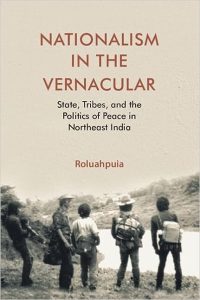In Nationalism in the Vernacular: Tribes, State and the Politics of Peace in Northeast India, Roluahpuia considers how oral culture has shaped the nationalist imagination of the Mizo, an indigenous population of Mizoram in Northeast India. Drawing on a rich array of source materials, Roluahpuia’s framework of vernacularity for understanding Mizo nationalism has significance for resistant and anti-colonial nationalisms across South Asia and beyond, writes Somingam PS.
Nationalism in the Vernacular: State, Tribes, and the Politics of Peace in Northeast India. Roluahpuia. Cambridge University Press. 2023.
 Roluahpuia’s Nationalism in the Vernacular: Tribes, State and the Politics of Peace in Northeast India is a captivating book that reframes ideas of nationalism in South Asia. Conventional theories of nationalism often employ modernist, constructivist and ethno-nationalist frames around top-down, urban-centric approaches. In the context of Indian nationalism, a focus on insurgency and secessionism predominates. Conversely, Roluahpuia, foregrounds a bottom-up approach, an everyday nationalism embedded in the vernacular domain of the Mizo people – a Tibeto-Burmese ethnic group indigenous to the state of Mizoram and neighbouring regions of Northeast India, Bangladesh and Myanmar.
Roluahpuia’s Nationalism in the Vernacular: Tribes, State and the Politics of Peace in Northeast India is a captivating book that reframes ideas of nationalism in South Asia. Conventional theories of nationalism often employ modernist, constructivist and ethno-nationalist frames around top-down, urban-centric approaches. In the context of Indian nationalism, a focus on insurgency and secessionism predominates. Conversely, Roluahpuia, foregrounds a bottom-up approach, an everyday nationalism embedded in the vernacular domain of the Mizo people – a Tibeto-Burmese ethnic group indigenous to the state of Mizoram and neighbouring regions of Northeast India, Bangladesh and Myanmar.
Roluahpuia foregrounds a bottom-up approach, an everyday nationalism embedded in the vernacular domain of the Mizo people
The book presents an alternative framework of how the everyday culture around orality, songs and language shaped Mizo national imaginations throughout Mizo history. Drawing from multiple sources – archival, oral narratives, memoirs and testimonies, official documents and media reports – the author foregrounds the vernacular consciousness of Mizos as the medium of articulating “Mizoness” as distinct from other ethnicities and cultures. This vernacularisation of Mizo national ideas was articulated through various genres of Mizo hla (songs): hnam hla (national songs), party hla (political party songs), and rambuai hla (songs of the troubled times) which have been instrumental in unifying and mobilising the masses, and in dissenting against the oppressor (traditional chiefs, colonial powers and Indian state authorities). Covering multiple locations in the territory, people with diverse social backgrounds, former rebels, victims of violence and rich archival sources, the book is a thorough exploration of Mizo experience and culture beyond the dominant Mizo group based in the capital, Aizawl.
Various genres of Mizo hla (songs) have been instrumental in unifying and mobilising the masses, and in dissenting against the oppressor (traditional chiefs, colonial powers and Indian state authorities)
The book addresses myopic readings of nationalism in the “post-colonial” era in northeast India and South Asia in general, which are often seen as a reactionary, identity-based movement with a goal of secessionism. In this figuration, Mizo nationalism emerged from the British colonial policy of isolation and transfigured it into secessionism, bolstered by the anti-India campaign of Christian missionaries. Roluahpui argues that this framing dismisses the socio-cultural and political agency of Mizos, portraying them as passive participants in the larger construction of colonial history and nation-state-making processes. The author debunks this by figuring Mizo as active in imagining, articulating, and constructing Mizo nationalism. The book posits the centrality of orality in articulating agency and its irrepressibility at the heart of Mizo nationalism.
The book posits the centrality of orality in articulating agency and its irrepressibility at the heart of Mizo nationalism.
Locating the Mizo within the larger socio-anthropological discourse of tribes in colonial, and “post-colonial” nation-state processes, the book problematises India’s political engagement with indigenous tribes. Roluahpui analyses the historical context of the state’s relationship its tribes including the India’s Constituent Assembly debates which were informed by assimilationist, isolationist, and integrationist schools of thought. In pursuit of the integrationist policy, India enacted legislation including the Sixth schedule (1949), the states reorganisation (1971) and the Mizoram Accord (1986) along with heavy militarisation to counteract the secessionist aspirations in the North Eastern Region. The book unveils the limits and positionality of this integrationist stance, an agenda to homogenise a new nation comprised of various ethnicities, religions and tribes. The author further interrogates the pretext of appropriating the anti-colonial tribal figures, culture, and histories that enforced historiographical representation of the Northeast into a “national” literature and curriculum. Meanwhile, discrimination against Northeastern people in Indian cities became routine.
The book unveils the limits and positionality of [postcolonial India’s] integrationist stance, an agenda to homogenise a new nation comprised of various ethnicities, religions and tribes
The book examines how Mizo nationalism emerged against this backdrop of British colonialism and later “post-colonial” India or “doubled colonialism” (in the words of sociologist, Viginius Xaxa) through the lens of the social and “cultural embeddedness” of the Mizo. It focuses on several hla (songs) composes and sung in response to historical events “to suit the emerging contexts” (49). Hnam hla (patriotic songs) were composed to assert claims to ‘autonomy’ over land, territory identity embedded in the Mizo political consciousness. The flexibility of Mizo vernacularity was remarkable in navigating through various upheavals, including the contestation against those traditional chiefs who allied with the colonial powers. Even after electoral politics set in, party hla (party songs) was introduced to mobilise and protest the anti-Mizo national campaigners (India’s integrationist forces).
The author also sheds light on how Mizo nationalism refashioned itself in response to the mautam (famine) in 1959, the suppression of Mizo language, and discrimination against their food habits and socio-cultural differences. In dissenting against the injustice of state oppression and homogenising forces, the Mizo National Front (MNF) re-articulated their nationalist imagination and ideals foregrounding the pride in Mizo identity, culture, and the land they inhabited. Against this backdrop, the idea of Zallena (freedom), ram leh hnam (territory and nation), and pathian leh kan ram tan (for God and our country) was re-imagined, re-articulated, making Mizo nationalist ideas accessible to masses in diverse forms. One significant aspect was how the orality of Mizo national consciousness became “mutually constitutive” (7) with print culture as Mizos began producing and disseminating nationalist ideals in written forms.
The orality of Mizo national consciousness became “mutually constitutive” (7) with print culture as Mizos began producing and disseminating nationalist ideals in written forms
During the counter-insurgency period (1967-1986), the intervention of nambuai hla (songs of the troubled times) which offered a vernacular space for finding solace, resilience and an “act of survivance” (115) against state censorship, terror and violence. Most importantly, it acted as a means of telling untold stories, asserting counter-discourse and resistance voices and provides alternatives to dominant state narratives.
Another fascinating section of the book is on “politics for peace” in Mizoram. The author argues that the Mizo Peace Accord was anchored by militaristic peace model “overshadowing the people’s experiences of violence, and terror in the conflict years” (143) to reinstate a homogenised order within the larger design of state’s governmentality. Roluahpui argues that the peace deal popularly celebrated by MNF and Indian government is an unsettled peace. Justice for the Mizo remains elusive, putting the durability of the peace deal into question.
What is ground-breaking about the book is how it spotlights repressed Mizo voices. Drawing its inspiration from subaltern scholarship and other contemporary literature on vernacular studies, a bottom-up approach through multiple methods and field sets this book apart. However, the book features less discussion on the influence of with several other nationalist and self-determination movements, particularly other decolonisation movement in Asia and Africa. It would be interesting to know how the Mizo context interacted with these parallel movements.
Roluahpui makes a compelling case for how the socio-cultural oral traditions and the political lifeworld of the Mizo continue to resist, re-imagine and express nationalism on their own terms
Overall, Roluahpui makes a compelling case for how the socio-cultural oral traditions and the political lifeworld of the Mizo continue to resist, re-imagine and express nationalism on their own terms. The book is an important intervention in the studies of nations and nationalism, tribal studies, Northeast India studies, border studies, peace and conflict studies and beyond.
Note: This review gives the views of the author, and not the position of the LSE Review of Books blog, or of the London School of Economics and Political Science. The LSE RB blog may receive a small commission if you choose to make a purchase through the above Amazon affiliate link. This is entirely independent of the coverage of the book on LSE Review of Books.
Image Credit: Mr.SMS on Shutterstock.






